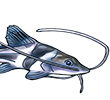Is this true? does anyone have any experience with this happening in their tanks?
Social/natural plec behaviour?
Social/natural plec behaviour?
Hi on various other forums I hear of plecos in general becoming more and more active/visable when kept in groups in particular the smaller sp.
Is this true? does anyone have any experience with this happening in their tanks?
Is this true? does anyone have any experience with this happening in their tanks?
-
Bas Pels
- Posts: 2913
- Joined: 21 Dec 2006, 20:35
- My images: 1
- My cats species list: 28 (i:0, k:0)
- Spotted: 8
- Location 1: the Netherlands
- Location 2: Nijmegen the Netherlands
- Interests: Central American and Uruguayan fishes
Re: Socal/natural plec behaviour?
I witnessed it with L75. Day active in quarantaine, until I seperated them into their final tanks. Soon after plcing them thei, I had problems with deseases, and they perished 
My Pt gibbyceps, however, were invicible their first year (I got them at 7 cm) having grown to 17 cm in the mean time. This has happened before with an earlier group
My Pt gibbyceps, however, were invicible their first year (I got them at 7 cm) having grown to 17 cm in the mean time. This has happened before with an earlier group
cats have whiskers
Re: Socal/natural plec behaviour?
Anyone else have plecos that are day active when in groups? 
Or strangly social, I'v read that most plecos are active because they are 'monitoring' thier territory?
Or strangly social, I'v read that most plecos are active because they are 'monitoring' thier territory?
- Shane
- Expert
- Posts: 4625
- Joined: 30 Dec 2002, 22:12
- My articles: 69
- My images: 161
- My catfish: 75
- My cats species list: 4 (i:75, k:0)
- My aquaria list: 5 (i:5)
- Spotted: 99
- Location 1: Tysons
- Location 2: Virginia
- Contact:
Re: Socal/natural plec behaviour?
Only a handful of loricariids are "social" in the sense that they are found naturally in groups. By and large this behavior is restricted to the Hypoptopominae (i.e. Otocinclus and their kin). I have seen underwater footage of huge groups of Hypostomus taken in Texas rivers, but am unsure if this type of behavior occurs in their native range. For most of the larger spp males will protect a fixed territory while females will move freely over a large area.
The negative side of this is that gill net fishing (a common practice in Amazonas) hits the females particularly hard. I have never done a scientific count, but have noticed that females make up most of the catch. This seems to be particularly true with Ancistrus where males guard a very small territory and do not move around much.
-Shane
The negative side of this is that gill net fishing (a common practice in Amazonas) hits the females particularly hard. I have never done a scientific count, but have noticed that females make up most of the catch. This seems to be particularly true with Ancistrus where males guard a very small territory and do not move around much.
-Shane
"My journey is at an end and the tale is told. The reader who has followed so faithfully and so far, they have the right to ask, what do I bring back? It can be summed up in three words. Concentrate upon Uganda."
Winston Churchill, My African Journey
Winston Churchill, My African Journey
- apistomaster
- Posts: 4735
- Joined: 10 Jun 2006, 14:26
- I've donated: $90.00!
- My articles: 1
- My cats species list: 12 (i:0, k:0)
- My Wishlist: 1
- Location 1: Clarkston, WA, USA
- Location 2: Clarkston, WA, USA
- Interests: Aquaculture and flyfishing
Re: Socal/natural plec behaviour?
Social behavior may be broadly defined.
I found when I kept about 6-7 each Hypancistrus L66, Hypancistrus L333 and Peckoltia L134 in a planted discus tank they would usually openly feed on sinking food pellets and frozen blood worms with the Discus and would chase each other around a lot as they competed for food. It could become quite a busy scene but once the food was gone the plecos made themselves fairly scarce. There was no shortage of hiding places for the plecos.
I found when I kept about 6-7 each Hypancistrus L66, Hypancistrus L333 and Peckoltia L134 in a planted discus tank they would usually openly feed on sinking food pellets and frozen blood worms with the Discus and would chase each other around a lot as they competed for food. It could become quite a busy scene but once the food was gone the plecos made themselves fairly scarce. There was no shortage of hiding places for the plecos.
Avid Trout fly fisherman. ·´¯`·...¸><)))º>




